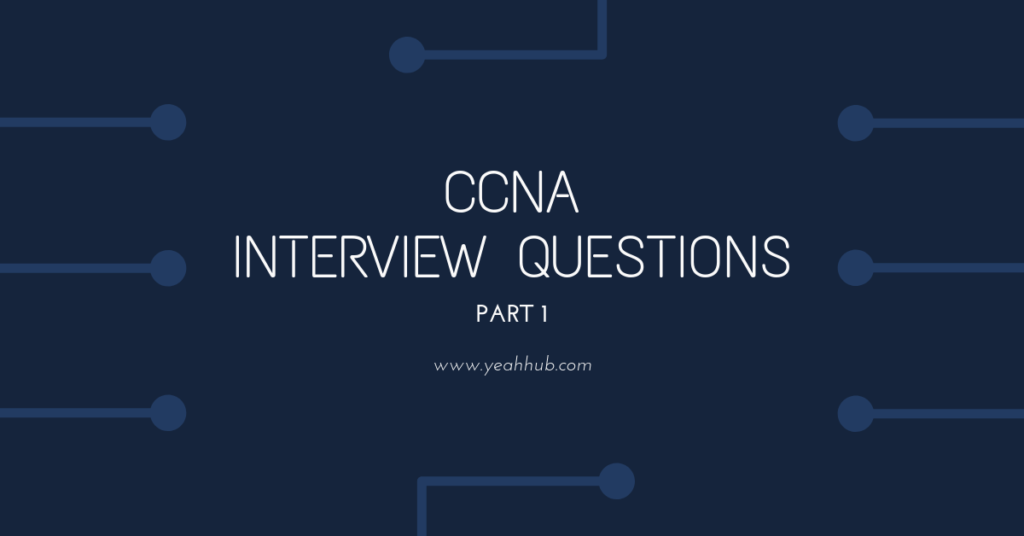
Part 1 | Part 2 | Part 3 | Part 4 | Part 5
Question 1: Which layer of the OSI model is responsible for reliable connections?
Answer: The Transport layer of the OSI model is responsible for reliable connections.
Question 2: What is the difference between acknowledgements and handshaking?
Answer: Handshaking is used to negotiate the properties of a connection that is being established. Acknowledgements are used to tell the sender that data has been successfully received by the destination during the use of a connection.
Question 3: How many VTP modes are there and what are they?
Answer: Three: Server, Client, and Transparent
Question 4: What are the two types of Trunk encapsulation protocols?
Answer: IEEE 802.1Q and Cisco’s ISL
Question 5: What are the four primary no routable protocols?
Answer: SNA, NetBIOS, DEC LAT, DEC MOP
Question 6: What is the difference between TCP and UDP?
Answer: The primary difference between TCP and UDP is that TCP is a connection oriented protocol and UDP is a connection less protocol.
Question 7: What is HSRP?
Answer: HSRP, or the Hot Standby Routing Protocol, is a Cisco proprietary protocol that brings routing functionality to end devices that would otherwise not be capable of taking advantage of redundant network connections. HSRP enables a pair of Cisco routers to work together to present the appearance of a single virtual default-gateway to end devices on a LAN segment.
Question 8: What is the difference between a Public IP address and a Private IP address?
Answer: Public address space is a unique address that is assigned to a company. Private address space is not recognized by the Internet and can be used by anyone within their private network.
Question 9: What does AAA stand for?
Answer: Authentication, authorization, and accounting
Question 10: The H.323 protocol is used for what?
Answer: H.323 is used for multi service (multimedia) applications, usually in a Voice Over IP environment.
Question 11: What type of routing protocol maintains neighbours?
Answer: Link State
Question 12: what is the range of values for administrative distance?
Answer: 0-255
Question 13: Describe the difference between uni cast, multi cast, and broadcast traffic?
Answer: Unicast traffic flows from a single source to a single destination MAC address. Multicast traffic flows from a single source MAC address to many destinations and uses a functional MAC address. Broadcast traffic is from a single source to all devices on the Ethernet segment. This is specified by a destination MAC address of all ones.
Question 14: What are the four different Ethernet encapsulation types?
Answer: From the Cisco IPX encapsulation command they are ARPA, NOVEL-ETHER, SAP and SNAP
Question 15: What are the three main tasks of a transparent bridge?
Answer: Learning, Forwarding, Filtering
Question 16: What type of routing protocol is EIGRP?
Answer: Hybrid
Question 17: While troubleshooting a connectivity problem on the network, you issue the ping command from your PC command prompt, but the output shows “request times out.” At which OSI layer is this problem associated with?
Answer: The Network Layer
Question 18: What algorithm does OSPF use to compute its route table?
Answer: OSPF uses the shortest path first (SPF) algorithm, which is also known as the Dijkstra algorithm.
Question 19: What is a stub area?
Answer: A stub area is an area that does not accept routing updates from outside its autonomous system.
Question 20: What does the TTL field of an IP packet header do?
Answer: The TTL field indicates the maximum time that a packet can be on the network. Each router that processes this packet decrements the TTL value by 1. If the value reaches zero, the packet is discarded from the network. The purpose of this field is to eliminate the possibility of a packet endlessly traversing the network.
Part 1 | Part 2 | Part 3 | Part 4 | Part 5
You may also like:- Top 10 Computer Fundamentals Questions and Answers
- Quiz Time – Testing Your Knowledge on Popular Computer Questions
- 15 Important Questions Related to Computer
- Certified Ethical Hacker v10 – Multiple Choice Questions with Answers – Part 14
- Certified Ethical Hacker v10 – Multiple Choice Questions with Answers – Part 13
- Certified Ethical Hacker v10 – Multiple Choice Questions with Answers – Part 12
- Certified Ethical Hacker v10 – Multiple Choice Questions with Answers – Part 11
- Certified Ethical Hacker v10 – Multiple Choice Questions with Answers – Part 10
- Certified Ethical Hacker v10 – Multiple Choice Questions with Answers – Part 9
- Certified Ethical Hacker v10 – Multiple Choice Questions with Answers – Part 8








